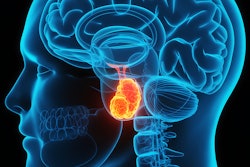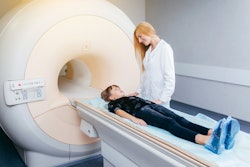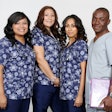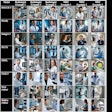
TORONTO - Ensuring safety for pediatric patients during MRI exams can be tricky, but taking precautionary steps is key, according to presentations given June 3 at the International Society for Magnetic Resonance in Medicine (ISMRM) annual meeting.
Three researchers presented ways to keep these patients safe and as comfortable as possible, accounting for temperature regulation in vulnerable preterm babies, as well as preventing burns and hearing impairment.
"We want them [babies] to be happy, healthy, and comfortable," said Nancy Beluk from UPMC Children's Hospital of Pittsburgh.
While precautions must be taken to mitigate injury risk for all patients undergoing MRI exams, special considerations must be taken for pediatric patients.
"Children are not just small adults. We cannot treat them the same," said Joanna Shectel, MD, from Vanderbilt University Medical Center in Tennessee. "They have very different and unique circumstances and risks."
 From left to right: Joanna Shectel, MD; Anton Glans; and Nancy Beluk respond to audience questions on pediatric MRI safety at the ISMRM annual meeting in Toronto.
From left to right: Joanna Shectel, MD; Anton Glans; and Nancy Beluk respond to audience questions on pediatric MRI safety at the ISMRM annual meeting in Toronto.Thermoregulation in premature babies
When babies are born prematurely, they are born without brown fat, a key component in the natural regulation of temperature. Because of this, preterm babies are more susceptible to hypo- and hyperthermia.
For MRI exams, this means taking necessary extra steps to help regulate their temperature. Beluk said clinics can implement some measures, including using portable MRI or incubator MRI to not disturb the baby's optimal temperature. Another innovation Beluk highlighted was vacuum bags full of small beads that are wrapped around the baby to hold them still.
Beluk added that MRI departments should take ownership in this area.
"It's so I can monitor it [MRI] and I can monitor it to make sure the oxygen tanks are compatible," she said. "When there's a baby who needs to go into the scanner, we need to bring this up into the neonatal intensive care unit and ask them what temperature they want the incubator to be."
Preventing burns
While between 59% and 70% of MRI incidents are from burns, pediatric patients are more prone to conduction burns, Shectel said. Some causes include wearing clothes with metallic fibers, bringing an emotional support item such as a teddy bear into the examination room, and pulse oximeters among others.
However, other factors may not be considered when preparing children for MRI exams. For instance, identification wristbands worn by infants may contain radiofrequency identification (RFID) tags that could be a heat risk. Shectel said these should be removed prior to examination, and that technologists should always check under any swaddling to make sure no risky objects are left in.
Also, tattoos that may be concealed by teenagers are a heat risk. Shectel said a cold compress lessens this risk.
She also outlined that sedated patients are at risk for more severe burns due to patients not able to give immediate feedback. She advised that technologists check for anesthesia wires to make sure they don't cross or loop together.
Shectel also called for future research to investigate the following topics: whether the size of the metal loop implant has a heat risk when there is a point of resistance, whether radiologists are being too conservative with orthodontic implants, and whether tissue loop burns are considered in neonates or small children.
Lowering acoustic noise
The gradient coils used to encode MR signals and interact with the magnetic field in MRI machines cause exams to be loud, sometimes exceeding 100 decibels (db). To compare, prolonged exposure to noise exceeding 85 db can cause hearing impairment.
"It [MRI noise] is equivalent to a rock concert, or a jackhammer, or a jet plane taking off," said Anton Glans, a doctoral student from Umeå University in Sweden.
A report by the U.S. Food and Drug Administration (FDA) said that about 6% of MRI incidents are related to acoustic noise. However, Glans said this may be underreported.
Glans said while there is a lack of research about the effect of noise exposure from MRI machines on pediatric patients, there are some generally accepted guidelines. For instance, 1.5-tesla MRI is generally safe for child patients, and pregnant healthcare workers should avoid MRI rooms.
However, toddlers can be protected from this by using noise-reduction objects such as earplugs and headphones, or a combination of both. He also said using soft gradient waveforms can help lessen exposure time to loud noises.
Glans also called for further development by vendors for a feedback tool to tell technologists how loud the machines are.
"It's important that we not get complacent about acoustic noise, not only for kids, but for everyone," he said. "We need to inform the patient to make them comfortable."




















